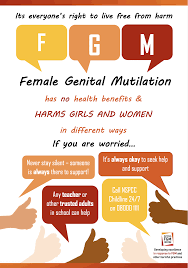Introduction:
Female genital mutilation (FGM), also known as female circumcision, is a practice that involves the partial or total removal of the external female genitalia or other bodily injuries for non-medical reasons. FGM is a human rights violation affecting millions of girls and women worldwide. Although it’s deeply rooted in cultural and social norms, educational institutions, particularly schools, play a crucial role in its eradication. This article explores the role of schools in preventing and mitigating the effects of FGM.
1. Raising Awareness:
Schools can use their influence to raise awareness of FGM by providing accurate information about its physical and psychological impacts. Teachers can incorporate discussions and lessons about FGM into various academic subjects such as social studies, health, and human rights education. By starting open conversations, students gain a better understanding of the issue at hand and learn why FGM must be eradicated.
2. Safe Space Creation:
Creating a safe environment in schools where victims feel comfortable speaking out is imperative. Schools can provide counseling services to support girls who have undergone or at risk of going through FGM. Such services may include therapy sessions led by trained professionals or peer support groups specialized in handling FGM-related issues.
3. Developing Policies and Reporting Mechanisms:
Effective policies around FGM can help prevent it from occurring within the school community. Schools should establish clear guidelines regarding reporting procedures for suspected cases of FGM, enabling staff to take appropriate action when required. Ensuring that these policies are well-communicated among students, staff, and parents will result in accountability and shared responsibility for protecting children.
4. Training School Staff:
Providing regular training to teachers and other school staff on the warning signs, consequences, and legal implications of FGM strengthens their ability to identify at-risk students effectively. Training sessions should cover cultural sensitivity and discuss ways to handle complex situations while respecting the rights and dignity of the affected individuals.
5. Collaborating with External Organizations:
Schools can work together with local and international organizations that focus on ending FGM. These partnerships can provide schools access to resources, expertise, and support networks. In turn, communities are empowered to initiate change and speak against FGM.
6. Encouraging Community Involvement:
Schools can strategically engage community leaders, parents, and other stakeholders by organizing seminars, workshops, or awareness campaigns around FGM. By actively involving communities, schools gain invaluable allies in the fight against this harmful practice.
Conclusion:
Female genital mutilation remains a significant global concern threatening the wellbeing of countless girls and women. Schools have a critical role in combatting this harmful practice by fostering awareness, creating safe spaces for victims, establishing effective policies, training staff members, collaborating with external organizations, and encouraging community involvement. Together, schools can become powerful catalysts for change and contribute significantly to the eradication of FGM.





